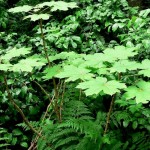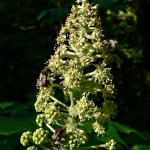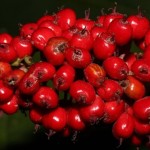Devils Club – Oplopanax horridus
|
Current Demand = Normal |
Parts Used: Root Bark |
 |
 |
 |
 |
Description:
Devils Club is a deciduous shrub that grows from 3-12 feet tall. The leaves are simple, alternate and deciduous. The leaves and stems have fine irritating prickles. The leaves are large (5-15 inches in diameter) palm lobed and cluster near the ends of the twigs, are bright green on top and a pale green on the underside. Small white flowers in upright, conical shape terminal cluster that grow 3-6 inches in length bloom from June to late August. It bears a bright red oval shape drupe in terminal clusters that are not edible. The twig and bark are sparse, upright, usually more than ½ inch in diameter, tan and armed with slender, stiff, irritating prickles.
Planting/Cultivation
Devil’s club is a fairly slow-sprouting plant, sometimes taking 18 months to germinate. It can be propagated vegetatively, by layering, and also self-propagates through root-crown sprouting. Oplopanax prefers clay or loam soil, with poor drainage, ample shade, and copious water. The soil in which it grows best is rich and has a low pH. Devil’s club grows naturally at high elevations or in northern latitudes, but can be cultivated elsewhere
Seed – best sown in a cold frame as soon as it is ripe in the autumn. When they are large enough to handle, prick the seedlings out into individual pots and grow them on in the greenhouse for at least their first winter. Plant them out into their permanent positions in late spring or early summer, after the last expected frosts. Division of suckers in the dormant season. Root cuttings in a greenhouse in the winter.
Harvesting/Drying:
Part Used: root bark
After harvest, the roots should be washed in cold water and foreign material (rocks, dirt and other roots) must be removed. Never soak roots in an attempt to clean them as this will extract vital nutrients etc.
Separate the stem from the root where the two meet at ground level and the root bark from the root.
The key to drying herbs, roots or bark is an even combination of heat and airflow. Never dry in an oven or a microwave.
Once the root is completely dry (the bark will snap and not bend) in 3-7 days depending on the size of the bark and the drying conditions, place in a cardboard box or paper bag for storage in a dry area until you are ready to sell or use. Do not place the root in plastic or it will mold.
Attributes (Images)
By Walter Siegmund (Own work) [GFDL, CC-BY-SA-3.0 or CC BY 2.5], via Wikimedia Commons
Stan Shebs [GFDL, CC BY-SA 3.0 or CC BY-SA 2.5], via Wikimedia Commons
 Root Buyer
Root Buyer